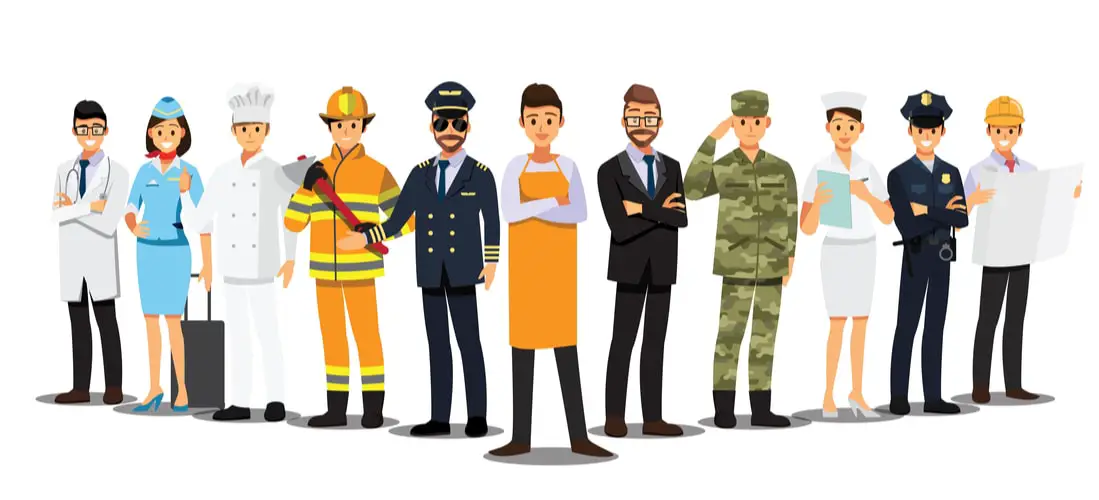Salary, Job Description, How To Become One, and Quiz
.jpg)
Fabric and Apparel Patternmakers
Fabric and Apparel Patternmakers draw and construct sets of precision master fabric patterns or layouts. May also mark and cut fabrics and apparel.
Table of contents
What they do
Fabric and Apparel Patternmakers draw and construct sets of precision master fabric patterns or layouts. May also mark and cut fabrics and apparel.
- Create a master pattern for each size within a range of garment sizes, using charts, drafting instruments, computers, or grading devices.
- Input specifications into computers to assist with pattern design and pattern cutting.
- Draw details on outlined parts to indicate where parts are to be joined, as well as the positions of pleats, pockets, buttonholes, and other features, using computers or drafting instruments.
- Make adjustments to patterns after fittings.
Typical day
On a daily basis, Fabric Patternmakers draw details on outlined parts to indicate where parts are to be joined, as well as the positions of pleats, pockets, buttonholes, and other features, using computers or drafting instruments. They test patterns by making and fitting sample garments.
A typical day for a Fabric and Apparel Patternmaker will also include:
- Discuss design specifications with designers, and convert their original models of garments into patterns of separate parts that can be laid out on a length of fabric.
- Make adjustments to patterns after fittings.
- Position and cut out master or sample patterns, using scissors and knives, or print out copies of patterns, using computers.
- Examine sketches, sample articles, and design specifications to determine quantities, shapes, and sizes of pattern parts, and to determine the amount of material or fabric required to make a product.
- Determine the best layout of pattern pieces to minimize waste of material, and mark fabric accordingly.
Other responsibilities
Besides their typical day, Fabric Patternmakers also create a paper pattern from which to mass-produce a design concept. They may also draw outlines of pattern parts by adapting or copying existing patterns, or by drafting new patterns.
On a weekly to monthly basis, Fabric Patternmakers test patterns by making and fitting sample garments. They might also trace outlines of paper onto cardboard patterns, and cut patterns into parts to make templates.
In addition, they examine sketches, sample articles, and design specifications to determine quantities, shapes, and sizes of pattern parts, and to determine the amount of material or fabric required to make a product.
Although specific duties may vary, many of them trace outlines of specified patterns onto material and cut fabric using scissors.
To some Fabric Patternmakers, it is also their responsibility to discuss design specifications with designers, and convert their original models of garments into patterns of separate parts that can be laid out on a length of fabric.
What is the job like
Job satisfaction
Is this job meaningful
50% said they were satisfied with their job and 25% said they found their job meaningful.

I am in charge of making the patterns that are used in a large or small factory to produce garments. Patternmakers need specialized studies at the industrial level to be able to do their work.
Patterns can be made in two ways: with a computer pattern program or manually, which is how we do it at Sugopetite.
What is your work life like?
When your passion is your job, it becomes easier, but it can be very demanding and stressful. The responsibility falls on the patternmaker to have the patterns made on time, and they must be perfect! There is no room for errors as a patternmaker because it could cost the loss of a full production run.
The passion I have for my work makes working at Sugopetite always something very pleasant as we develop different designs.
Pros
The pros of being a pattern maker is to be recognized for your excellent work and dedication to it; this allows you to have job stability in the company you work for.
Cons
The cons are always going to be reflected in the responsibility of making mistakes because it can be fatal when making a production run. Also, it is a tiring job because you spend a lot of time either in front of a computer or at a table working the patterns. Sometimes it is necessary to work overtime since there are productions that are urgent.
The most important thing of all is to be able to work in a pleasant environment and as family as we do at Sugopetite. We don’t even notice the hours we spend working together.
Pros
Suitable for people who like practical and hands-on work.
Suitable for people who value relationships between co-workers and customers and want to work in a friendly non-competitive environment.
This career is perfect for people who love to work indoors.
It is not too difficult to get into this career. Previous work-related skill, knowledge, or experience is required for this career.
Cons
Not suitable for people who like to help and teach others.
Salary is below average.
Demand for this career is declining.
How much do they make
Average salary
Average hourly wage
Entry-level Fabric and Apparel Patternmakers with little to no experience can expect to make anywhere between $27,210 to $34,230 per year or $13 to $16 per hour.
| Salary by experience | Annual | Hourly |
|---|---|---|
| Highest (Top 10%) | $102,660 | $49 |
| Senior (Top 25%) | $76,970 | $37 |
| Median | $49,680 | $24 |
| Junior (Bottom 25%) | $34,230 | $16 |
| No experience (Bottom 10%) | $27,210 | $13 |
This table shows the top 10 highest paying industries for Fabric and Apparel Patternmakers based on their average annual salary.
| Salary by industry | Annual | Hourly |
|---|---|---|
| Apparel, Piece Goods, and Notions Merchant Wholesalers | $84340 | $40.55 |
| Management of Companies and Enterprises | $83670 | $40.22 |
| Clothing Stores | $62080 | $29.85 |
| Cut and Sew Apparel Manufacturing | $61080 | $29.37 |
| Fabric Mills | $52820 | $25.39 |
| Employment Services | $51810 | $24.91 |
| Specialized Design Services | $47260 | $22.72 |
| Furniture and Related Product Manufacturing | $45920 | $22.08 |
| Other Textile Product Mills | $45180 | $21.72 |
| Electronic Shopping and Mail-Order Houses | $ | $* |
View more salary by industries here.
Where can they work
Where can Fabric and Apparel Patternmakers work? Here is a table showing the top 10 largest employers of Fabric and Apparel Patternmakers including the average salary in that industry.
| Employers | Total Employed | Annual Salary | Hourly Wages |
|---|---|---|---|
| Cut and Sew Apparel Manufacturing | 1410 | $61080 | $29.37 |
| Furniture and Related Product Manufacturing | 1200 | $45920 | $22.08 |
| Management of Companies and Enterprises | 480 | $83670 | $40.22 |
| Apparel, Piece Goods, and Notions Merchant Wholesalers | 320 | $84340 | $40.55 |
| Clothing Stores | 260 | $62080 | $29.85 |
| Other Textile Product Mills | 180 | $45180 | $21.72 |
| Employment Services | 130 | $51810 | $24.91 |
| Electronic Shopping and Mail-Order Houses | 70 | $ | $* |
| Fabric Mills | 40 | $52820 | $25.39 |
| Specialized Design Services | $47260 | $22.72 |
What is the work day like
Working hours
Working schedule
How often do you use email in this job?
Telephone
How often do you have telephone conversations in this job?
Group discussions
How often do you have group discussions in this job?
Public speaking
How often does this job require you to do public speaking?
Level of competition
How much competitive pressure is in this job?
What is the work environment like
Office-style environment
Indoors in an environmentally controlled condition
Warehouse-style environment
Indoors in a non-controlled environmental condition such as a warehouse
Outdoors
Outdoors exposed to all weather conditions
Outdoors – Under Cover
Outdoors but under cover (e.g. structure with roof but no walls)
How to become one
Difficulty to become one
Required level of education
What level of education do you need to perform the job?
Relevant majors
Apparel and Textile Manufacture
Relevant work experience
How much related work experience do you need to get hired for the job?
On The Job Training
How much on the job training do you need to perform the job?
Should you become one
Best personality type for this career
People with this personality type likes practical and hands-on work. They prefer working with plants, animals, and real-world materials like wood, tools, and machinery.
People with The Builder personality type likes practical and hands-on work. They prefer working with plants, animals, and real-world materials like wood, tools, and machinery.
People with The Thinker personality likes to work with ideas that require an extensive amount of thinking. They prefer work that requires them to solve problems mentally.
People with The Artist personality likes to work with designs and patterns. They prefer activities that require self-expression and prefer work that can be done without following a clear set of rules.
People with The Helper personality type likes to work with people and in teams. They prefer work that allows them to build relationships with others.
People with The Leader personality likes to start and work on projects. They also like leading people and making many decisions.
People with The Organizer personality type likes to follow set procedures and routines. They prefer working with data and details more than with ideas.
You can read more about these career personality types here.
People who are suitable for this job tend to like work activities that include practical, hands-on problems and solutions. They like working with plants, animals, and real-world materials like wood, tools, and machinery.
They also like working with forms, designs, and patterns. They often require self-expression and the work can be done without following a clear set of rules.
Take this quiz to see if this is the right career for you.
Work Values
Which values are the most important to a person’s satisfaction for this job?
You are someone who is results oriented. You prefer work that allows you to utilize your skills and abilities while at the same time giving you a sense of accomplishment.
You are someone who values job security, steady employment, and good working conditions. You also prefer work that keeps you busy all the time with something different to do every day.
You are someone who values job advancement and leadership roles. You prefer work that receives recognition for the work you do and jobs that are looked up to by others in the company and your community.
You are someone who likes to provide a service to others. You prefer a work environment where you can work with your co-workers in a friendly non-competitive environment.
You are someone who values a company that stands behind their employees. You prefer a work environment where everyone is treated fairly and is being supported by the company.
You are someone who likes to work on your own and make your own decisions. You prefer work that requires little supervision and are allowed to try out your own ideas.
Don’t know which career to pursue?
Take the career quiz to find careers that match your personality type.
Take The Career Quiz
.jpg)




.jpg)
.jpg)
.jpg)
.jpg)
.jpg)
.jpg)
.jpg)
.jpg)
